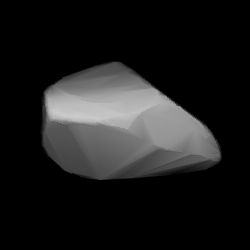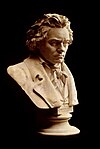Related Research Articles
2069 Hubble, provisional designation 1955 FT, is a carbonaceous asteroid from the outer region of the asteroid belt, approximately 40 kilometers in diameter. It was discovered on 29 March 1955, by the Indiana Asteroid Program at Goethe Link Observatory, United States, and named after American astronomer Edwin Hubble.
2127 Tanya, provisional designation 1971 KB1, is a carbonaceous asteroid from the outer region of the asteroid belt, approximately 40 kilometers in diameter. It was discovered on 29 May 1971, by Russian astronomer Lyudmila Chernykh at the Crimean Astrophysical Observatory in Nauchnij, on the Crimean peninsula. It was named in memory of Tanya Savicheva, a Russian child diarist during World War II.
997 Priska, provisional designation 1923 NR, is a carbonaceous Adeonian asteroid from the central regions of the asteroid belt, approximately 19 kilometers in diameter. It was discovered on 12 July 1923, by astronomer Karl Reinmuth at the Heidelberg-Königstuhl State Observatory in southwest Germany. The asteroid's name is a common German female name, unrelated to the discoverer's contemporaries.
Pawlowia, provisional designation 1923 OX, is a background asteroid from the central regions of the asteroid belt, approximately 20 kilometers in diameter. It was discovered on 5 October 1923, by Soviet astronomer Vladimir Albitsky at the Simeiz Observatory on the Crimean peninsula. The asteroid was named after Russian physiologist and Nobelist Ivan Pavlov.
La Paz, provisional designation 1923 PD, is a carbonaceous asteroid from the outer region of the asteroid belt, approximately 40 kilometers in diameter. It was discovered on 31 October 1923, by German astronomer Max Wolf at the Heidelberg-Königstuhl State Observatory and named after the city La Paz in Bolivia.

1073 Gellivara, provisional designation 1923 OW, is a dark Themistian asteroid, approximately 27 kilometers in diameter, located in the outer regions of the asteroid belt. It was discovered by Austrian astronomer Johann Palisa at the Vienna Observatory on 14 September 1923, and later named after the Swedish town of Gällivare.

1032 Pafuri, provisional designation 1924 SA, is a dark background asteroid from the outer regions of the asteroid belt, approximately 65 kilometers in diameter. It was discovered on 30 May 1924, by English astronomer Harry Edwin Wood at the Union Observatory in Johannesburg, South Africa. The asteroid was named for the river in the Pafuri Triangle in South Africa, created by the confluence of the Limpopo and Levubu rivers. The body's spectral type and rotation period are still poorly determined.
1295 Deflotte, provisional designation 1933 WD, is a carbonaceous asteroid from the outer regions of the asteroid belt, approximately 48 kilometers in diameter. It was discovered on 25 November 1933, by French astronomer Louis Boyer at the Algiers Observatory in Algeria, North Africa. The asteroid was named after the discoverer's nephew.

1555 Dejan, provisional designation 1941 SA, is an asteroid from the background population of the central regions of the asteroid belt, approximately 22 kilometers in diameter. It was discovered on 15 September 1941, by Belgian astronomer Fernand Rigaux at the Royal Observatory of Belgium in Uccle. The asteroid was named after Dejan Đurković, son of Serbian astronomer Petar Đurković.
1421 Esperanto, provisional designation 1936 FQ, is a dark background asteroid from the outer regions of the asteroid belt, approximately 55 kilometers in diameter. It was discovered on 18 March 1936, by Finnish astronomer Yrjö Väisälä at the Iso-Heikkilä Observatory in Turku, southwest Finland. The presumed C-type asteroid has a rotation period of nearly 22 hours. It was named for the artificial language Esperanto.
1267 Geertruida, provisional designation 1930 HD, is a carbonaceous background asteroid from the inner regions of the asteroid belt, approximately 20 kilometers in diameter. Discovered by astronomer Hendrik van Gent at Johannesburg Observatory in 1930, the asteroid was later named after Geertruid Pels, sister of Dutch astronomer Gerrit Pels.
2324 Janice, provisional designation 1978 VS4, is a dark background asteroid from the outer regions of the asteroid belt, approximately 25 kilometers (16 miles) in diameter. It was discovered on 7 November 1978, by American astronomers Eleanor Helin and Schelte Bus at the Palomar Observatory in California. The asteroid was named for Janice Cline at Caltech. The presumably C-type asteroid has a rotation period of 23.2 hours.
6255 Kuma, provisional designation 1994 XT, is a carbonaceous asteroid from the central region of the asteroid belt, approximately 22 kilometers in diameter. It was discovered on 5 December 1994, by Japanese astronomer Akimasa Nakamura at Kuma Kogen Astronomical Observatory on the Island of Shikoku, Japan. It was named after the Japanese town of Kumakōgen.
4804 Pasteur, provisional designation 1989 XC1, is a carbonaceous background asteroid from the central regions of the asteroid belt, approximately 20 kilometers in diameter. It was discovered on 2 December 1989, by Belgian astronomer Eric Elst at the ESO's La Silla Observatory in Chile. The asteroid was named after French chemist and microbiologist Louis Pasteur.
1238 Predappia, provisional designation 1932 CA, is a dark Adeonian asteroid from the central regions of the asteroid belt, approximately 21 kilometers in diameter. It was discovered on 4 February 1932, by astronomer Luigi Volta at the Observatory of Turin in Pino Torinese, Italy. It was later named after the Italian village of Predappio.

1436 Salonta, provisional designation 1936 YA, is a dark background asteroid from the outer regions of the asteroid belt, approximately 60 kilometers in diameter. Discovered by György Kulin at the Konkoly Observatory in 1936, the asteroid was later named for the Romanian city of Salonta, the birthplace of the discoverer.

1424 Sundmania is a large asteroid and rather slow rotator from the background population of the outer regions of the asteroid belt. It was discovered on 9 January 1937, by astronomer Yrjö Väisälä at the Turku Observatory in southwest Finland. The dark X-type asteroid has a notably long rotation period of 93.7 hours and measures approximately 70 kilometers in diameter. It was named after Finnish astronomer and mathematician Karl F. Sundman.

2120 Tyumenia is a dark background asteroid, approximately 45 kilometers in diameter, located in the outer regions of the asteroid belt. It was discovered on 9 September 1967, by Soviet astronomer Tamara Smirnova at the Crimean Astrophysical Observatory in Nauchnyj, on the Crimean peninsula. The asteroid was named for the now Russian district of Tyumen Oblast in Western Siberia.

1301 Yvonne is a carbonaceous background asteroid from the background population of the intermediate asteroid belt, approximately 21 kilometers in diameter. It was discovered on 7 March 1934, by French astronomer Louis Boyer at the Algiers Observatory in North Africa. The asteroid was named for the discoverer's sister, Yvonne Boyer
1242 Zambesia is a dark background asteroid from the central regions of the asteroid belt, approximately 48 kilometers in diameter. It was discovered on 28 April 1932, by South African astronomer Cyril Jackson at the Union Observatory in Johannesburg. The asteroid was named for the large Zambezi basin in southern Africa.
References
- 1 2 3 4 5 6 7 8 "1815 Beethoven (1932 CE1)". Minor Planet Center. Retrieved 7 December 2018.
- 1 2 3 4 5 6 7 8 "JPL Small-Body Database Browser: 1815 Beethoven (1932 CE1)" (2018-09-10 last obs.). Jet Propulsion Laboratory . Retrieved 7 December 2018.
- 1 2 3 4 5 "Asteroid 1815 Beethoven". Small Bodies Data Ferret. Retrieved 7 December 2018.
- 1 2 "Asteroid (1815) Beethoven – Proper elements". AstDyS-2, Asteroids – Dynamic Site. Retrieved 4 December 2018.
- 1 2 3 4 Nugent, C. R.; Mainzer, A.; Bauer, J.; Cutri, R. M.; Kramer, E. A.; Grav, T.; et al. (September 2016). "NEOWISE Reactivation Mission Year Two: Asteroid Diameters and Albedos". The Astronomical Journal. 152 (3): 12. arXiv: 1606.08923 . Bibcode:2016AJ....152...63N. doi: 10.3847/0004-6256/152/3/63 .
- 1 2 3 4 Masiero, Joseph R.; Mainzer, A. K.; Grav, T.; Bauer, J. M.; Cutri, R. M.; Nugent, C.; et al. (November 2012). "Preliminary Analysis of WISE/NEOWISE 3-Band Cryogenic and Post-cryogenic Observations of Main Belt Asteroids". The Astrophysical Journal Letters. 759 (1): 5. arXiv: 1209.5794 . Bibcode:2012ApJ...759L...8M. doi:10.1088/2041-8205/759/1/L8. S2CID 46350317.
- 1 2 3 4 Tedesco, E. F.; Noah, P. V.; Noah, M.; Price, S. D. (October 2004). "IRAS Minor Planet Survey V6.0". NASA Planetary Data System – IRAS-A-FPA-3-RDR-IMPS-V6.0: IRAS-A-FPA-3-RDR-IMPS-V6.0. Bibcode:2004PDSS...12.....T . Retrieved 17 October 2019.
- 1 2 3 4 Mainzer, A. K.; Bauer, J. M.; Cutri, R. M.; Grav, T.; Kramer, E. A.; Masiero, J. R.; et al. (June 2016). "NEOWISE Diameters and Albedos V1.0". NASA Planetary Data System: EAR-A-COMPIL-5-NEOWISEDIAM-V1.0. Bibcode:2016PDSS..247.....M . Retrieved 7 December 2018.
- 1 2 Masiero, Joseph R.; Grav, T.; Mainzer, A. K.; Nugent, C. R.; Bauer, J. M.; Stevenson, R.; et al. (August 2014). "Main-belt Asteroids with WISE/NEOWISE: Near-infrared Albedos". The Astrophysical Journal. 791 (2): 11. arXiv: 1406.6645 . Bibcode:2014ApJ...791..121M. doi:10.1088/0004-637X/791/2/121. S2CID 119293330.
- 1 2 3 4 Usui, Fumihiko; Kuroda, Daisuke; Müller, Thomas G.; Hasegawa, Sunao; Ishiguro, Masateru; Ootsubo, Takafumi; et al. (October 2011). "Asteroid Catalog Using Akari: AKARI/IRC Mid-Infrared Asteroid Survey". Publications of the Astronomical Society of Japan. 63 (5): 1117–1138. Bibcode:2011PASJ...63.1117U. doi:10.1093/pasj/63.5.1117. (online, AcuA catalog p. 153)
- 1 2 3 4 Mainzer, A.; Grav, T.; Masiero, J.; Hand, E.; Bauer, J.; Tholen, D.; et al. (November 2011). "NEOWISE Studies of Spectrophotometrically Classified Asteroids: Preliminary Results". The Astrophysical Journal. 741 (2): 25. arXiv: 1109.6407 . Bibcode:2011ApJ...741...90M. doi:10.1088/0004-637X/741/2/90. S2CID 35447010. (catalog)
- 1 2 Stephens, Robert D. (September 2005). "Asteroid lightcurve photometry from Santana Observatory - winter 2005". The Minor Planet Bulletin. 32 (3): 66–68. Bibcode:2005MPBu...32...66S. ISSN 1052-8091.
- 1 2 3 4 5 "LCDB Data for (1815) Beethoven". Asteroid Lightcurve Database (LCDB). Retrieved 7 December 2018.
- ↑ Schmadel, Lutz D. (2009). "Appendix – Publication Dates of the MPCs". Dictionary of Minor Planet Names – Addendum to Fifth Edition (2006–2008). Springer Berlin Heidelberg. p. 221. Bibcode:2009dmpn.book.....S. doi:10.1007/978-3-642-01965-4. ISBN 978-3-642-01964-7.
